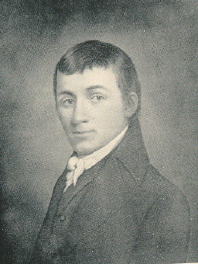| Charles Brockden Brown  Born: 17-Jan-1771 Born: 17-Jan-1771
Birthplace: Philadelphia, PA
Died: 22-Feb-1810
Location of death: Philadelphia, PA
Cause of death: Tuberculosis
Remains: Buried, Friends Arch Street Meeting House Burial Ground, Philadelphia, PA
Gender: Male
Religion: Quaker
Race or Ethnicity: White
Sexual orientation: Straight
Occupation: Novelist Nationality: United States
Executive summary: First American novelist, Wieland American novelist, was born of Quaker parents in Philadelphia, on the 17th of January 1771. Of delicate constitution and retiring habits, he early devoted himself to study; his principal amusement was the invention of ideal architectural designs, devised on the most extensive and elaborate scale. This characteristic talent for construction subsequently assumed the shape of Utopian projects for perfect commonwealths, and at a later period of a series of novels distinguished by the ingenuity and consistent evolution of the plot. The transition between these intellectual phases is marked by a juvenile romance, entitled Carsol, not published until after the authors death, which professes to depict an imaginary community, and shows how thoroughly the young American was inspired by Godwin and Mary Wollstonecraft, whose principal writings had recently made their appearance. From the latter he derived the idea of his next work, The Dialogue of Alcuin (1797), an enthusiastic but inexperienced essay on the question of woman's rights and liberties. From Godwin he learned his terse style, condensed to a fault, but too laconic for eloquence or modulation, and the art of developing a plot from a single psychological problem or mysterious circumstance. The novels which he now rapidly produced offer the strongest affinity to Caleb Williams, and if inferior to that remarkable work in subtlety of mental analysis, greatly surpass it in affluence of invention and intensity of poetical feeling. All are wild and weird in conception, with incidents bordering on the preternatural, yet the limit of possibility is never transgressed. In Wieland; or the Transformation (1798), the first and most striking, a seemingly inexplicable mystery is resolved into a case of ventriloquism. Arthur Mervyn; or Memoirs of the Year 1793 (1798-1800), is remarkable for the description of the epidemic of yellow fever in Philadelphia. Edgar Huntly (Philadelphia, 1801), a romance rich in local coloring, is remarkable for the effective use made of somnambulism, and anticipates Cooper's introduction of the American Indian into fiction. Ormond (1799) is less powerful, but contains one character, Constantia Dudley, which excited the enthusiastic admiration of Shelley. Two subsequent novels, Clara Howard (1801) and Jane Talbot (1804), dealing with ordinary life, proved failures, and Brown betook himself to compiling a general system of geography, editing a periodical, and an annual register, and writing political pamphlets. He died of consumption on the 22nd of February 1810. He is depicted by his biographer as the purest and most amiable of men, and in spite of a certain formality, due perhaps to his Quaker education, the statement is borne out by his correspondence. Father: Elijah Brown
Mother: Mary Armitt Brown
Wife: Elizabeth Linn (Presbyterian, m. 1804)
High School: Friends Latin School, Philadelphia, PA
Is the subject of books:
Charles Brockden Brown, American Gothic Novelist, 1949, BY: Harry R. Warfel
Charles Brockden Brown, Pioneer Voice of America, 1952, BY: David L. Clark
Charles Brockden Brown: An American Tale, 1983, BY: A. Axelrod
Author of books:
Alcuin: A Dialogue (1798)
Wieland (1798, novel)
Ormond (1799, novel)
Edgar Huntly (1799, novel)
Arthur Mervyn (1799-1800, novel, two volumes)
Clara Howard (1801, novel)
Jane Talbot (1801, novel)
Do you know something we don't?
Submit a correction or make a comment about this profile
Copyright ©2019 Soylent Communications
|